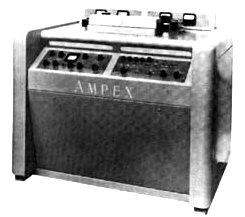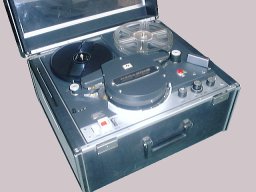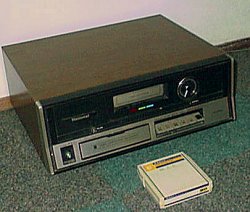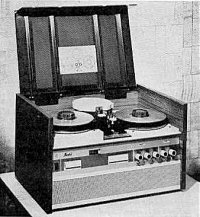| The exhibits in this room are background displays, covering the technology behind radio, television and
magnetic recording. These are not strictly part of the story of home video, but are relevant because they define
the problems which had to be overcome in order to produce a practical home video recorder. |
| Television began in Britain, in the 1930s. Broadcasts were suspended during World War II, but resumed in
the late 40's and television really boomed in the 1950s. There was soon an urgent need to find some way of recording
television programs - particularly in the United States, where the country spanned several time-zones, and the
evening news in New York would be received in the mid-afternoon in California.
The first solution was TeleCine, pointing a film camera at a TV monitor and filming the picture directly.
But this was slow (since the film had to be developed) poor quality, and prone to distortion. |
| Magnetic tape recording was an obvious solution - it was actually invented in the 19th century, and
had been widely used for recording sound since the war - but the
high-bandwidth signals used by television required a very high tape speed; the first machines ran the tape at speeds
measured in metres per second - the equivalent of 150 kph (90 mph), in one case... |
| This was clearly impractical (and dangerous!), but Ampex solved the problem in 1956 with the
Quadruplex format. They realized that the speed at which the tape moves through the machine doesn't need to
have anything to do with the speed that the heads move past the tape. |
The Quad system mounted the recording heads on a spinning disc so that they passed at high speed
across the width of the tape, writing short tracks across it rather than one long track along it.
The 2-inch tape was held in a curve using compressed air, and the tracks were written vertically across its width as
it moved slowly past:
 |
|

The first Quad machine
|
|
| As each of the four heads reached the bottom of the tape, the next one was ready to start at the top.
The disc span at 250rps, so the heads each wrote 15 or 16 lines (for a 625 line PAL machine).
But, since the heads had to be switched during a picture, head matching and alignment was critical to avoid
disturbance on the image.
The famous "Normal service will be resumed as soon as possible" message often covered some frantic
head-cleaning and re-alignment of these notoriously finicky machines. |
| The big breakthrough came in 1960, with the invention of the Helical Scan system. Rather than a vertical
disk, the head disk was mounted at a shallow angle to the tape. This allowed a whole field to be written without a break,
in a diagonal stripe, and so the switch from one head to the other came "off-screen". This was more practical
as it required much less precise alignment, and it also allowed a still-frame to be produced -- the same field could be
read reapeatedly with the tape stopped. |
 |
| Helical scanning made small VTRs practical, and throughout the 60's they became
popular for all manner of presentation, security and training uses. |
A typical reel-to-reel helical VTR from the late 1960's.
The tape had to be laced by hand, around the various guides, rollers and the large head drum in the centre.
Note the rather optimistic carrying handle!
By the end of the decade a standard had emerged, EIAJ, which meant that most (though not all)
VTRs were compatible, and cassette and cartridge loading systems helped to avoid the complexity
and potential tape-damage of manual lacing. |
|
 |
|

| |
An EIAJ cartridge machine from National
Unlike a cassette
machine, the tape must be fully rewound before the catridge can be removed.
But these machines were more at home in a small studio than the home, and required some technical
knowledge to own and run . A true home video system was elusive, and the few attempts made to market one at
this time - such as the linear Wesgrove system sold as a kit in 1962 - failed to make any significant impact. |
|
If you want to know more about the technology behind radio, television and magnetic tape recording, use the
remote control to visit the exhibits in this room.
A reel-to-reel VTR from Norelco (Philips), from about 1965
This machine was demonstrated for home use -- using a very original technique to connect it to a TV:
it picked up the signal directly from the TV's circuits,
using a device which was slipped over
one of the valves (vacuum tubes) inside! |
|

|
|





